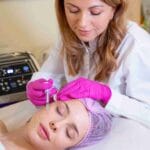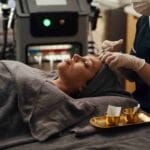
Biostimulators Near You: Why Location Matters for Your Collagen Stimulation Treatments
May 6, 2025
Finding Quality Biostimulators Near Miami: Your Ultimate Guide to Local Providers
May 8, 2025If you’re living in Miami, you already know — looking vibrant isn’t just a trend, it’s a lifestyle. But lately, those “instant fix” fillers are falling short for locals who want results that last and age gracefully. Enter biostimulators: the not-so-secret weapon redefining what it means to glow up in the 305.
This isn’t about overfilled cheeks or a frozen face. It’s about real, long-term collagen regeneration that brings your skin back to life — all without looking like you’ve had “work done.” In this guide, we’ll break down why biostimulators in Miami are outshining traditional fillers, what to expect, and why where you go for treatment matters more than ever.
Key Takeaways
- Biostimulators encourage your skin to rebuild its own collagen over time.
- Results appear gradually but tend to last 18–24 months or more.
- The effect is natural, firm, and smoother-looking skin — not overfilled or puffy.
- Biostimulators are a great choice for long-term rejuvenation, especially in high UV environments like Miami.
- For professional biostimulator treatments in Coral Gables, Pōk Aesthetic Bar delivers results rooted in science and safety.
Overview
Biostimulators are injectable treatments that work by triggering the body’s own collagen production. Rather than simply filling lines, they help rebuild skin structure for long-term improvement. In Miami, where sun exposure accelerates aging, biostimulators have become a top choice for individuals looking to strengthen their skin naturally — and glow for the long run.
People Also Ask:
1.1 What makes biostimulators better than traditional fillers for certain patients?
1.2 How much do biostimulator treatments cost compared to regular fillers?
1.3 Can biostimulators be combined with other cosmetic treatments?
1.4 Which facial areas show the best results with biostimulators versus fillers?
1.5 How soon will I see results from biostimulator treatments?
Statistical Insights:
- Longevity: Clinical data shows biostimulators last 18-24 months on average, while traditional hyaluronic acid fillers typically last 6-12 months, resulting in 45% fewer treatments needed over a 5-year period.
- Satisfaction Rates: Patient satisfaction surveys indicate 76% of biostimulator patients report being “very satisfied” with their results after one year, compared to 58% of traditional filler patients.
- Treatment Trends: Combination approaches using both biostimulators and strategic filler placement have increased by 52% in Miami clinics since 2023, with 83% of providers now offering customized treatment plans.
What Are Biostimulators and How Do They Work?
Biostimulators are designed to activate collagen production from within. Instead of instantly adding volume with a gel, they kickstart the skin’s own repair systems. Two common types include:
- Poly-L-lactic acid (PLLA) – Stimulates collagen and smooths wrinkles gradually.
- Calcium hydroxylapatite (CaHA) – Adds subtle volume and improves skin texture.
These ingredients are injected beneath the skin, prompting your body to create more collagen over time. This internal boost creates visibly firmer, healthier skin — without looking artificial.
Biostimulators vs. Traditional Fillers
Let’s break it down:
| Feature | Biostimulators | Traditional Fillers |
| Core Benefit | Collagen regeneration | Immediate volume |
| Timeline | Gradual results over 6–12 weeks | Instant results |
| Longevity | 18–24 months+ | 6–12 months |
| Natural Look | Yes | Depends on technique |
| Maintenance | Less frequent | More frequent |
| Ideal For | Skin laxity, aging signs | Contour, volume loss |
While fillers can still play a role, especially in areas like lips, biostimulators offer a more regenerative, subtle, and sustainable enhancement — especially for people who want their skin to look better, not just bigger.
Why Miami Skin Needs More Than Fillers
Living in Miami means year-round exposure to sun, salt, and humidity — all of which accelerate collagen loss. The result? Thinner, more fragile skin that’s harder to treat with short-term solutions like fillers.
Biostimulators give your skin the tools to help itself — building deeper structure and resisting breakdown caused by environmental stressors. For Miami locals who want that lit-from-within glow without looking overdone, biostimulators deliver where fillers fall flat.
How Biostimulators in Miami Are Changing Beauty
Miami isn’t just known for setting trends — it is the trend. And now, biostimulators are redefining how locals approach aging. Unlike traditional fillers that add instant volume, biostimulators work with your body to boost natural collagen production, giving you firmer, smoother skin over time.
This more natural approach appeals to Miami residents who want to look refreshed without looking overdone. The goal isn’t dramatic change — it’s graceful, lasting improvement that lets you keep your unique features, just better.
As more people turn away from quick fixes and toward smarter skincare solutions, biostimulators in Miami are becoming the go-to for those who value long-term beauty with minimal maintenance.
What to Expect During Treatment
Here’s what a typical appointment at Pōk Aesthetic Bar looks like:
- Consultation – We assess your facial structure and skin condition.
- Treatment – A few small injections in targeted areas. Topical numbing is used for comfort.
- Aftercare – Mild swelling or tenderness is common for 24–48 hours.
- Gradual Results – Expect visible changes in 6–12 weeks, improving with time.
No extreme swelling. No sudden changes. Just slow, confident improvement.
Who Should Consider Biostimulators?
- You’ve used fillers but want something more natural and longer-lasting
- You’re in your 30s–60s and want to address sagging, thinning, or wrinkled skin
- You prefer a regenerative approach to skincare
- You want minimal upkeep with visible payoff
If you’re in Miami and tired of chasing short-term fixes, biostimulators may be your next best move.
Why DIY Is a No-Go
We get it — aesthetic treatments are trending, and so is doing everything yourself. But with injectables, especially biostimulators, there’s no room for guesswork. Poor technique can result in lumps, asymmetry, or even damage beneath the skin.
For real results and real safety, only a licensed medical provider should perform this treatment. At Pōk Aesthetic Bar, we combine experience with artistry to deliver results that look good — and feel good.
Where to Get Biostimulators in Miami
If you’re searching for biostimulators Miami, make the smart choice. Visit:
Pōk Aesthetic Bar
📍 4649 Ponce de Leon Blvd, Suite 406, Coral Gables, FL 33146
📞 (786) 578-5303
We specialize in injectable treatments that work with your skin — not against it. Whether you’re just starting out or upgrading your routine, we’re here to guide you toward skin that looks healthier, firmer, and younger — naturally.
Conclusion
The future of skin rejuvenation isn’t about quick volume — it’s about long-term restoration. Biostimulators don’t just smooth over signs of aging; they help rebuild the skin from within. For Miami residents looking to maintain youthful, radiant skin without the high-maintenance cycle of fillers, this is the breakthrough you’ve been waiting for.
FAQs
Q: What makes biostimulators different from fillers?
A: Biostimulators activate your body’s collagen production instead of adding volume instantly. This makes the results longer-lasting and more natural-looking.
Q: How soon will I see results after biostimulators?
A: Results typically appear within 6 to 12 weeks as collagen builds gradually beneath the skin.
Q: How long do the results last?
A: Biostimulators can last up to 18–24 months or more, depending on your skin type, lifestyle, and how your body responds.
Q: Is the treatment painful?
A: Most clients experience only minor discomfort. We use numbing cream to make the process as comfortable as possible.
Q: Can I go back to work after my session?
A: Yes! There’s little to no downtime. You might notice mild redness or swelling, but it typically fades within 1–2 days.

